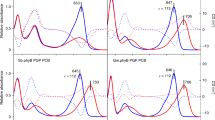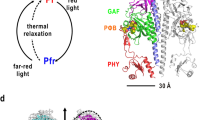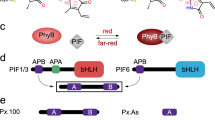Abstract
The biological activity of the plant photochromic photoreceptor, phytochrome, is generally thought to reside in Pfr the far-red-absorbing form, whilst the red-absorbing Pr is inactive. This view is based solely on incomplete correlations between spectrophotometrically detectable Pfr and responses in etiolated tissues given brief light treatments1,2. Studies of light-grown seedlings have recently revealed an inverse, linear relationship between phytochrome-regulated extension growth and phytochrome photoequilibrium (defined as Pfr/(Pr+Pfr) and estimated from the spectral photon distribution of the actinic radiation)3–10. Such a relationship could only fit the ‘Pfr as active form’ theory if Pr+Pfr (that is, Ptotal) remained constant and independent of the light sources used. Here I report data from herbicide-bleached, light-grown maize seedlings which show that Ptotal is strongly dependent on the wavelength distribution of the radiation and that the amount of Pfr does not correlate with growth response.
This is a preview of subscription content, access via your institution
Access options
Subscribe to this journal
Receive 51 print issues and online access
$199.00 per year
only $3.90 per issue
Buy this article
- Purchase on Springer Link
- Instant access to full article PDF
Prices may be subject to local taxes which are calculated during checkout
Similar content being viewed by others
References
Oelze-Karow, H. & Mohr, H. Photochem. Photobiol. 18, 319–330 (1973).
Drumm, H. & Mohr, H. Photochem. Photobiol. 20, 151–157 (1974).
Holmes, M. G. & Smith, H. Nature 254, 512–514 (1975).
Holmes, M. G. & Smith, H. Photochem. Photobiol. 25, 551–557 (1977).
McLaren, J. S. & Smith, H. Pl. Cell Envir. 1, 61–67 (1978).
Morgan, D. C. & Smith, H. Nature 262, 210–212 (1976).
Morgan, D. C. & Smith, H. Planta 142, 187–193 (1978).
Morgan, D. C. & Smith, H. Planta 145, 253–258 (1979).
Morgan, D. C., O'Brien, T. & Smith, H. Planta 150, 95–196 (1980).
Smith, H. & Holmes, M. G. Photochem. Photobiol. 25, 547–550 (1977).
Hilton, J. L., Scharen, A. L., St. John, J. B., Moreland, D. E. & Norris, K. H. Weed Sci. 17, 541–547 (1969).
Jabben, M. & Deitzer, G. F. Photochem. Photobiol. 27, 799–802 (1978).
Jabben, M. & Deitzer, G. F. Pl. Physiol. 63, 481–485 (1979).
Jabben, M. Planta 149, 91–96 (1980).
Heathcote, L., Bambridge, K. R. & McLaren, J. S. J. exp. Bot. 30, 347–353 (1969).
Schäfer, E. J. math. Biol. 2, 41–56 (1975).
Gorton, H. L. & Briggs, W. R. Pl. Physiol. 66, 1024–1026 (1980).
Johnson, C. B. & Tasker, R. Pl. Cell Envir. 2, 259–268 (1979).
Pratt, L. H. Photochem. Photobiol. 27, 81–105 (1978).
Author information
Authors and Affiliations
Rights and permissions
About this article
Cite this article
Smith, H. Evidence that Pfr is not the active form of phytochrome in light-grown maize. Nature 293, 163–165 (1981). https://doi.org/10.1038/293163a0
Received:
Accepted:
Issue Date:
DOI: https://doi.org/10.1038/293163a0
This article is cited by
Comments
By submitting a comment you agree to abide by our Terms and Community Guidelines. If you find something abusive or that does not comply with our terms or guidelines please flag it as inappropriate.



